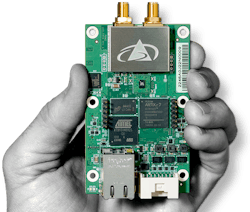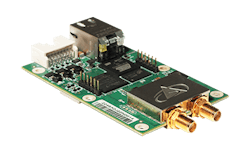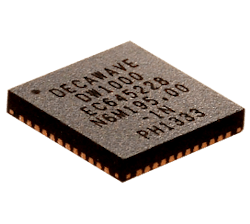This file type includes high-resolution graphics and schematics when applicable.
Crowded frequency spectrum has led to renewed interest in ultrawideband (UWB) radio technology. With a growing number of wireless electronic devices occupying finite bandwidth, UWB technology, also known as impulse radio, offers the potential to share the available bandwidth with broadband, low-power pulses. Such pulses can communicate not only large amounts of information across short distances, but directional information much like the radar systems that they mimic. If implemented properly, UWB radios can coexist with conventional wireless radio systems, appearing much like background noise to those other systems.
UWB technology comes in two forms: multicarrier (MC) UWB communications, in which multiple simultaneous carriers are used to transfer information; and as short-duration pulses that are used to transfer information. Multicarrier UWB communications is fairly straightforward. It has been employed with various different modulation formats, including orthogonal-frequency-division-multiplex (OFDM) modulation, to achieve high data rates. Impulse UWB radio formats may be the more intriguing of the two UWB types, though, with the ability to transfer data across bandwidths already occupied by other radio formats.
UWB radio technology has never seen widespread use in any market areas. But the scarcity of available frequency spectrum due to the influx of wireless applications and forthcoming data-heavy Internet of Things (IoT) networks may open up realistic opportunities for this technology. It could particularly benefit impulse UWB radars, which can share bandwidth with existing applications. Pulsed UWB radios provide the means to move remote data wirelessly across short distances, and may serve as suitable wireless interconnections between many IoT sensors and gateways to the Internet.
Impulse UWB radios transmit and receive pulses much like a radar system, with the one difference being that no target is being illuminated by those pulses. If anything, an UWB receiver is the target and is tasked with the time-sensitive reception of short-duration pulses that occupy broad bandwidths of spectrum.
In the United States, the Federal Communications Commission (FCC) in 2002 set aside the frequency range from 3.1 to 10.6 GHz for UWB usage. Since other applications have to function within this frequency range, UWB systems must operate without interfering with those other narrowband and wideband systems. The FCC also set a transmission power limit of –41.3 dBm/MHz or 75 nW. Moreover, UWB systems face the challenge of receiving low-level signals from a signal environment where much higher-level signals already exist (which might be considered jammer signals to a radar system).
Taking the Pulse of UWB
Use of pulsed signals in UWB radios enables successful communications, even in environments with severe multipath conditions as typified by crowded wireless bands. Military users have been intrigued by the great potential of UWB communications equipment for many years, since it relies on low-power pulsed signals with low probability of interception and detection for secure communications.
The data rates possible with UWB signals are a function of the power spectral density (PSD) of a system, with higher data rates potentially a tradeoff with transmit power. The large instantaneous bandwidth of UWB signals enables three-dimensional (3D) distance and time resolution to precisely position the source of received radio signals.
Pulse shaping is typically employed to ensure that UWB transmissions remain within the power- and spectral-density limitations set by the FCC in the U.S. and ETSI in Europe. Pulse shaping also prevents the spread of electromagnetic (EM) energy into occupied radio bands to enable coexistence with other wireless applications. To satisfy the required spectral mask, digital filtering—including the use of finite-impulse-response (FIR) filters—has proven effective.
A Smattering of Products
In spite of its benefits, commercial UWB communications products haven’t exactly exploded onto the market. Few manufacturers have taken the plunge into a technology that’s admittedly much different than popular, conventional radio systems residing within clearly defined segments of the frequency spectrum, such as LTE and Wi-Fi.
One company that has made progress with practical hardware and software for UWB applications is Time Domain. The firm has developed a number of reliable UWB radio systems, including its P330 and P440 compact PulsON radio modules (Fig. 1).
The P330 offers ranging and high-speed communications capabilities. As a ranging radio, it uses two-way time-of-flight (TW-TOF) ranging to measure the distance between two or more P330 radios. Ranging samples are performed at rates to 200 measurements/s (200 Hz) with accuracy of 10 cm across ranging distances to 100 m. As a communications device, the P330, which supports multiband operation, reaches data rates up to 6.8 Mb/s in compliance with IEEE 802.15.4a standard for wireless ranging and communications. The compact hardware module is backed by the firm’s suite of ranging and localization software for precise TW-TOF measurements, including in networks optimized for such measurements.
The P330, as with the P440, is designed and constructed for industrial environments, with an operating temperature range of –40 to +85°C and typical power consumption of 1 W. It measures 56 × 103 × 18 mm with antenna connectors and complies with FCC Part 15 regulations in the U.S. and ETSI EN 302 065 standard mask for use in Europe.
The P440 UWB radio module (Fig. 2) also features TW-TOF ranging at rates to 125 Hz and 2-cm accuracy out to 500 m. As with the P330, it can operate with either the ALOHA or TDMA protocol for ranging purposes. With its pulsed signals, it works as a monostatic, bistatic, or multistatic radar, and is able to achieve high rejection of clutter for target recognition inside buildings and within other challenging operating environments. The P440 module is based on the FIFE (Fully Integrated Front End) chip, Time Domain’s sixth generation of custom UWB silicon, specifically a mixed-signal Silicon Germanium (SiGe) application-specific integrated circuit (ASIC). Central to the P440’s precise ranging performance is FIFE’s timing engine, designed to maintain timing accuracy at the picosecond level.
At the heart of the P330 is the model DW1000 silicon CMOS integrated circuit (IC) from fabless Irish semiconductor supplier DecaWave. The DW1000 (Fig. 3), a single-chip UWB transceiver with 10-cm indoor location precision, can also communicate at data rates to 6.8 Mb/s using pulsed UWB time-synchronized signals. Designed to support high-data-rate IoT devices in wireless sensor networks, the DW1000 UWB transceiver chip uses coherent receiver techniques to achieve a communications range to 290 m. It is highly immune to multipath fading and operates with extremely low power consumption to further extend battery life in portable and remote applications.
For system developers, DecaWave offers DW1000 UWB evaluation kits. It offers flexible operation, supporting six different frequency bands with center frequencies from 3.5 to 6.5 GHz. The DW1000 UWB IC, fabricated with 90-nm CMOS technology, can run on supplies from +2.8 to 3.6 V dc, with only 31-mA current consumption in transmit mode and 64-mA current consumption in receive mode.
Housed in a 6- × 6-mm 48-pin QFN package, the DW1000 transmits at power levels of –10 to –14 dBm, achieving transmit power density of –41.3 dBm/MHz. It works with biphase modulation (BPM) and binary-phase-shift-keying (BPSK) modulation to achieve reliable, high-speed data rates in severe industrial environments.
Another supplier of UWB radios is Multispectral Solutions, recently acquired by Zebra Technologies Corp. Multispectral’s UWB digital voice/data radio operates with 1-W peak transmit power and 400-MHz instantaneous bandwidth to achieve transmission rates of 128 kb/s for voice and 115.2 kb/s for data. It achieves a range of 1 to 2 km with low-profile omnidirectional antennas
The antenna, of course, is an important part of any UWB radio system. Numerous multiple-band antennas have been developed to work at two or more “narrowband” wireless frequency bands at the same time, such as Bluetooth and Wi-Fi. But in UWB systems, antennas must receive all frequencies at the same time across a wide bandwidth, preferably with nondispersive characteristics. As a result, their design tends to be more challenging than the others.
Antennas for UWB use are typically categorized as being directional or nondirectional. Directional antennas provide higher gain than nondirectional or omnidirectional antennas, and are typically larger with more limited fields of view. In most cases, the advantages of UWB radio systems are best realized with miniature omnidirectional antennas, although directional antennas serve well when greater range is needed for a given transmit power level.
About the Author
Jack Browne
Technical Contributor
Jack Browne, Technical Contributor, has worked in technical publishing for over 30 years. He managed the content and production of three technical journals while at the American Institute of Physics, including Medical Physics and the Journal of Vacuum Science & Technology. He has been a Publisher and Editor for Penton Media, started the firm’s Wireless Symposium & Exhibition trade show in 1993, and currently serves as Technical Contributor for that company's Microwaves & RF magazine. Browne, who holds a BS in Mathematics from City College of New York and BA degrees in English and Philosophy from Fordham University, is a member of the IEEE.




